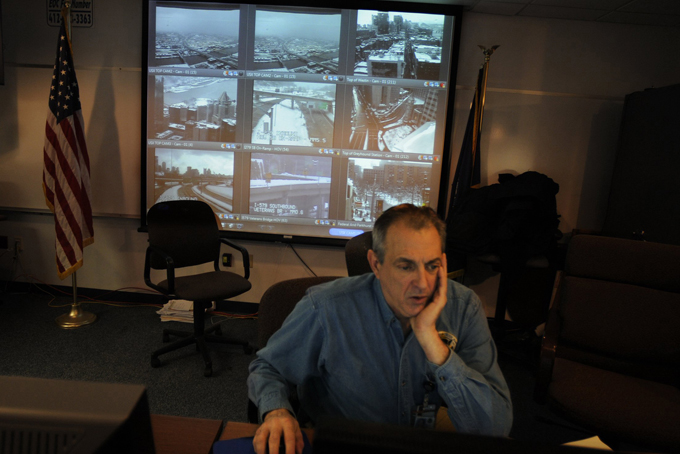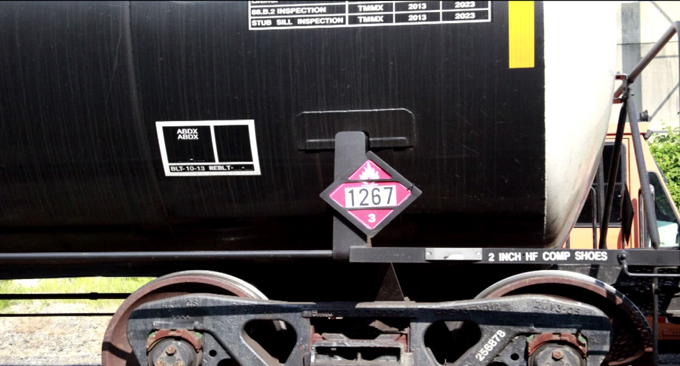
Emergency response officials are currently assessing the risks that trains carrying millions of gallons of highly combustible crude oil pose to residents in Southwestern Pennsylvania.
Raymond DeMichiei (Dee-Mi-Shay), deputy director of Pittsburgh’s Office of Emergency Management and Homeland Security, is overseeing that appraisal.
“We don’t want people to have a false sense of security,” he said. “Yes, there is a risk. [But] we’re managing the risk.”
Trains carrying crude snake through Pittsburgh and the region on their way from North Dakota’s Bakken Shale fields to refineries in Philadelphia and other East Coast cities.
Pittsburgh landmarks that could be in the line of fire if a train exploded, he said, are all of downtown, Heinz Field, PNC Park and the CONSOL Energy Center.
All are within a half mile of rail lines that carry crude oil, said DeMichiei.
A half mile on each side of railroad tracks is the federally recommended evacuation zone if a crude-oil train fire occurs.
https://publicsource.org/investigations/top-pittsburgh-emergency-response-official-talks-about-risks-of-crude-oil-trains#.VCBAHlfc_N4
City officials are identifying critical infrastructure that could be involved including dams, cell towers and natural gas facilities and fire stations, he said. And special needs populations that could be harmed including hospitals, schools, nursing homes and daycare centers.
Responders may not be available to respond, he said, if their own facility, such as a fire station, is involved.
The assessment will be used to determine what the hazards are and whether emergency responders need additional training or materials, he said.
“Bakken Crude is a little different and its a newer hazard, and it has some unique things to it, so that’s the reason we are looking at it as hard as we are,” DeMichiei said.
A surge in U.S. oil production has made railroads the main means of transporting crude oil to refineries. Trains now carry more than 4,000 percent more crude than they did in 2008.
The crude oil boom has meant more derailments; the worst was in July 2013 in Lac Megantic, Quebec, where 47 people were killed when a train exploded. The number of derailments has people concerned about one of these trains exploding in a major city, like Pittsburgh or Philadelphia.
Pittsburgh emergency response officials began the risk assessment after railroads were ordered by the U.S. Department of Transportation to turn over information about rail lines that carry a million gallons or more of Bakken crude oil at a time.
The city is doing the risk assessment for all of Southwestern Pennsylvania.
Bakken crude, according to a spokesman for the state’s emergency management agency, moves through 10 counties in the region: Allegheny, Beaver, Armstrong, Butler, Cambria, Fayette, Indiana, Westmoreland, Somerset and Lawrence.

How to identify a train carrying crude oil
There’s a red triangle-shaped placard on the side of tank cars that carry crude oil with the code: 1267. This is a U.S. Department of Transportation classification code that identifies the hazardous material for emergency responders.
Are you prepared?
The average American doesn’t often think about what they’d do in an emergency.
What would you do if you couldn’t reach a family member on a cell phone? Or, what if a hospital is affected and can’t take emergency patients?
How would you get your family to a safe place if a there was a crude oil accident on a rail line near your house?
If you don’t know, you’re not alone, DeMichiei said. Most people don’t know what to do in case of an emergency, but they should, he said.
“People should be aware of the risks and they should think about how they are going to react if something bad happens,” said DeMichiei. He suggests if people living near railroad tracks see trains carrying Bakken crude or any other hazardous material, they should have a plan in case an accident happens.
He said people should ask themselves these questions: “Do you know if the window in your bedroom opens? Is it big enough for you to get out? Is there a porch you can get on? What do you tell your kids if there’s a fire?”
“If it were me…If I hear [a noise] and I hear a train derailment and I see flames, I’m not even thinking about it: Here’s my stuff, I’m grabbing it, I’m gone. I have my family members trained. You don’t go back home, you meet me at the Home Depot parking lot down in East Liberty,” said DeMichiei, who added he sees about two Bakken trains a day along Route 28 in Pittsburgh, his route to and from work.
DeMichiei said he’s not trying to scare people or make them panic. He just wants them to be prepared if a disaster happens. And if a big disaster occurs, there’s only so much government and emergency responders can do, he said.
“We really want to encourage a degree of self reliance on the part of citizens,” he said.
“You’re not going to find anyone from emergency management and homeland security who is going to sit there and say nothing’s going to happen,” he said.
“Anything could happen,” he said.
How much information?
Once the assessment is done, city officials will limit the information they release because it will also limit information to potential terrorists, DeMichiei said.
“There’s a clear value for the public to understand the risks … but only up to a point,” he said.
“We don’t want folks to know, well, here’s where all the infrastructure is, and all this other stuff, and, oh, that’s the place to make the thing blow up because we are going to get the most critical infrastructure, schools [and] hospitals.”
City officials will also talk to the railroads about additional training first responders might need and will assess whether they have enough materials to fight an oil fire.
The flip side of that, DeMichiei said, is that “you never have enough” materials. He equated it to local governments lacking the ability to put a police officer on every corner.
“You can do that, if you have the money. But we don’t,” he said. “So what we have to do is do an evaluation of the risk and then we need to put in place what is reasonable and appropriate.”
Emergency response officials from across the country have testified before Congress that responders wouldn’t be prepared to handle a large-scale crude oil disaster like the deadly one in Quebec.
Since the uptick in crude oil train traffic, Norfolk Southern and CSX, the railroads hauling Bakken crude through Pennsylvania, have offered more training to first responders. In August, Norfolk Southern held a training in Pitcairn, Pa., near Pittsburgh, where first responders were able to get an up-close look at railroad equipment and talk to rail experts.
This month, CSX announced a first-of-its-kind mobile app for first responders to access train information when responding to incidents.
Under a recent voluntary agreement with the DOT, the rail industry committed $5 million for training first responders nationwide.
The agency ordered railroads to give emergency response agencies information on the routing, frequency and volumes of crude-oil trains after it found the information was not “security sensitive” for anti-terrorism purposes.
Some states, including Virginia, California and Illinois, released some of the information to the public based on their state public records laws. But others, including Pennsylvania, signed non-disclosure agreements with the railroads.
“The information we shared with states in compliance with the May 7 Executive Order is sensitive both for security and commercial reasons, and we’ve asked states to maintain its confidentiality for those reasons,” said Rob Doolittle, a spokesman for CSX.
The Pennsylvania Emergency Management Agency (PEMA) denied Right-to-Know requests from news organizations, including PublicSource, for the information.
Several news organizations have appealed to the Pennsylvania Office of Open Records for the information.
So, that means Pennsylvania residents don’t know exactly where crude oil trains are traveling, how much they’re carrying and how frequently they pass through.
PublicSource created a map using using a perimeter of a half-mile on each side of rail lines that could carry crude oil in the city. By that standard, more than 40 percent of Pittsburgh’s residents live in areas at risk if a train carrying crude oil derails and catches fire.
Reach Natasha Khan at 412-415-0261 or nkhan@publicsource.org. Follow her on twitter @khantasha.
https://publicsource.org/investigations/top-pittsburgh-emergency-response-official-talks-about-risks-of-crude-oil-trains#.VCBAHlfc_N4
